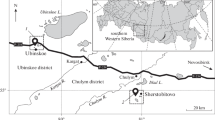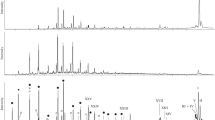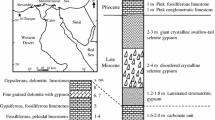Abstract
Samples of carbonate and siliceous-carbonate deposits of Semiluk—Sargaev horizons of the N‒NE slope of the South Tatar uplift, Volga-Ural petroliferous basin, have been studied. Specific feature of the source rocks—high concentration of compounds—anoxia testifiers in the photic layer has been identified. That is, organic matter has been deposited under the conditions of the constant presence of anoxia in the photic layer of the sedimentation basin at sufficiently high thickness of the water column contaminated with hydrogen sulfide. Since by the composition of saturated hydrocarbons the studied samples are typical for deposits of the Semiluk horizon of the central part of the Volga-Ural basin, we can assume a fairly wide prevalence of such conditions within the South-Tatar arch. Changes in the concentrations of the components—anoxia markers—show cyclical changes in output layer contaminated with hydrogen sulfide or its bioproduction within the studied time.
Similar content being viewed by others
References
V. A. Bochkarev, S. B. Ostroukhov, and S. E. Sianisyan, “Concept of two-stage formation of hydrocarbon reservoirs in the western wall of the Caspian Basin,” in Success in Organic Geochemistry. Proceedings of All-Russian Conference, Novosibirsk, Russia, 2010 (Novosibirsk, 2010), pp. 64–69 (2010) [in Russian].
E. S. Brodksii, “Mass-spectrometric analysis of hydrocarbons and geteroatomic oil compounds,” in Methods of Study of Organic Compounds of Oil and Bitumens (Nauka, Moscow, 1985), pp. 57–118 [in Russian].
D. A. Bushnev, “The composition of biomarkers in bitumen and pyrolysis products of kerogen from the Pechora-Basin Upper Devonian deposits,” Petrol. Chem. 42 (5), 291–305 (2002).
D. A. Bushnev, “Early Cretaceous anoxic basin of the Russian Plate: organic geochemistry,” Lithol. Miner. Resour. 40 (1), 21–29 (2005).
D. A. Bushnev, N. S. Burdel’naya, E. S. Ponomarenko, and T. A. Zubova (Kiryukhina), “Anoxia in the domanik basin of the Timan–Pechora Region,” Lithol. Miner. Resour. 51 (4), 283–289 (2016).
D. J. Cliffford, J. L. Clayton, and J. S. S. Damste, “2,3,6-/3,4,5-Trimethyl substituted diaryl carotenoid derivatives (Chlorobiaceae) in petroleums in the Belorussian Pripyat River Basin,” Org. Geochem. 29 (5–7), 1253–1267 (1998).
G. N. Gordadze and V. I. Tikhomirov, “Geochemical characteristics of oils and dispersed organic matter from the rocks of the Central Volga–Ural Basin: hydrocarbon biomarker data,” Geochem. Int. 43 (11), 1108–1123 (2005).
W. A. Hartgers, J. S. S. Damste, A. G. Requejo, J. Allan, J. H. Hayes, Y. Ling, T.-M. Xie, J. Primack, and J. W. de Leeuw, “A molecular and carbon isotopic study towards the origin and diagenetic fate of diaromatic carotenoids,” Adv. Org. Geochem. 1993. Org. Geochem, 22 (3–5), 703–725 (1994).
R. S. Khisamov, T. A. Shardanova, A. V. Stupakova, N. P. Fadeeva, A. N. Khomyak, and V. L. Kosorukov, “Lithological–sedimentation model of the formation of highly carbonaceous complexes,” in Prospects for Increase of Resource Base of Developed Deposits, Including Domanik Sediments (PAO Tatneft, Al’met’evsk, 2015), pp. 30–45 [in Russian].
M. P. Koopmans, J. Koster, H. M. E. van-Kaam-Peters, F. Kenig, S. Schouten, W. A. Hartgers, J. W. de Leeuw, and J. S. S. Damste, “Diagenetic and catagenetic products of isorenieratene: molecular indicators for photic zone anoxia,” Geochim. Cosmochim. Acta, 60 (22), 4467–4496 (1996).
S. B. Ostroukhov, O. A. Aref’ev, V. M. Makushina, M. N. Zabrodina, and Al. A. Petrov, “Monocyclic aromatic hydrocarbons with isoprenoid chain,” Neftekhimiya 22 (6), 723–728 (1982).
G. S. Pevneva, A. K. Golovko, and E. A. Fursenko, “Distribution of alkylarenes in petroleums from sediments of different age,” in Success in Organic Geochemistry. Proceedings of All-Russian Conference, Novosibirsk, Russia, 2010 (Novosibirsk, 2010), pp. 269–272.
Al. A. Petrov, Petroleum Hydrocarbons (Nauka, Moscow, 1984) [in Russian].
M. B. Smirnov, E. N. Poludetkina, and N. A. Vanyukova, “Experience in application of NMR 1H and 13C spectroscopy for comparative analysis of composition of petroleums and petrolenes in source rocks by the example of the Volga–Ural PB,” in Conference of INKhS devoted to the 80 th Anniversary of N.A. Plate, Moscow, Russia, 2014 (Moscow, 2014), p. 104 [in Russian].
Author information
Authors and Affiliations
Corresponding author
Additional information
The article was translated by the authors.
Published in Russian in Geokhimiya, 2017, No. 8, pp. 730–740.
Rights and permissions
About this article
Cite this article
Poludetkina, E.N., Smirnov, M.B., Fadeeva, N.P. et al. Proof of formation of organic matter in upper Devonian carbonate and carbonate-siliceous sediments of the South-Tatar uplift in constant photic layer anoxia. Geochem. Int. 55, 726–736 (2017). https://doi.org/10.1134/S0016702917080079
Received:
Published:
Issue Date:
DOI: https://doi.org/10.1134/S0016702917080079




